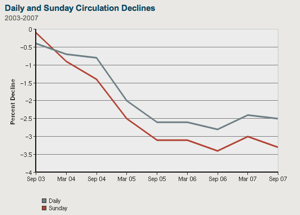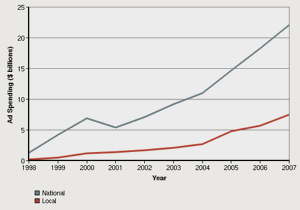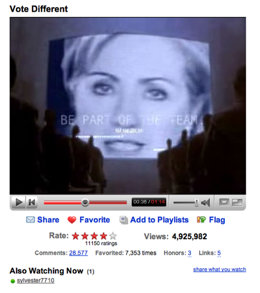
Last week, I had the honor of giving a speech at Arkansas State University, as part of their Lecture & Concert series — at least, once I made it through the mechanical mayhem of American Airlines cancelling dozens of flights the same day I flew out. I also got to address a few classes in the College of Communications there, and meet with students who put together the school newspaper.
It was heartening that out in the middle of the heartland of the U.S., classes on citizen journalism and public affairs reporting are being taken seriously. Plus, the students who work on the school newspaper (and who get paid to do so!) have been adding lots of original video reports to the newspaper’s website.
As with my visit last year to Ball State, I heard the same complaints from professors who say that students like to use technology for fun and socializing but don’t consider the journalistic possibilities of social networks, YouTube and other new technology. This is a gap that needs to be closed at schools teaching journalism.
I want to share some of the main points of my talk at Arkansas State, much of which I have discussed in detail here on MediaShift, but haven’t really brought together in one place.
Change in Media Usage
Before I get into the rules, I want to give some important background into the major shift going on in media usage — especially as it relates to journalism and news. There is a move away from traditional media and toward online media.
These figures come out of the new State of the News Media 2008, from the Project for Excellence in Journalism.

> Newspapers ended 2007 with 8.4% less circulation daily and 11.4% less Sunday than in 2001. Plus, print newspaper ad revenues experienced their worst drop in more than 50 years, according to the Newspaper Association of America.
> The main TV network news programs averaged 23.1 million viewers a night, a drop of 5%, or 1.2 million viewers compared with data from 2006. Over the past 25 years, the audience has fallen around 1 million per year.
When I interviewed NBC anchor Brian Williams a couple years ago, he boasted:
On some nights we split an audience three ways of 30 million Americans, and I don’t need to tell you that you can’t come close to that audience in any other medium. The fact that ‘Nightly News’ most nights leads the pack by — I don’t know what the numbers are — makes us the largest single source of news in the United States by an enormous margin. There’s no newspaper, there’s no website, there’s no news site that comes even close.
That might be true, but it’s an audience that is decreasing — and getting older — each passing year.
> In traditional broadcast radio, total reach went from 95.3% of Americans to 93.3% — not as harsh as other mediums.
> The major newsmagazines — Time, Newsweek, and US News — have seen flat circulation for the past several years. They would be down even further except that they give big discounts to people on subscriptions.
> Meanwhile, online news consumption is up. In 2000, 60% of people said they had got news online ever; 22% said they did it “yesterday” — a gauge for regular readers. In late 2007, the number who got online news ever was up to 71% and 37% said they were online for news “yesterday.”
This shows a big change in attention: People’s habits are changing, as they go online for news more often and regularly.

> In advertising, Borrell Research says that local online ads brought in 32% more money in 2007, hitting $7.5 billion, while national ads saw a 20% increase in revenues. A Veronis Suhler Stevenson study found that consumers were spending 17% of their media consumption time with the web — but the medium made up just 8% of total ad expenditures. That gap means there’s even more growth ahead for online ads, as marketers realize they need to spend more money where people are spending their time.
The New Rules of Media
1. The Audience Knows More Than the Journalist
(News Is a Conversation and Not a Lecture)
In 2002, Dan Gillmor was live-blogging a speech by Qwest CEO Joe Nacchio at the PC Forum conference. Nacchio was complaining about how hard it was to raise capital. Meanwhile, Buzz Bruggeman wrote in to Gillmor, noting that Nacchio had made hundreds of millions of dollars at the company, and Gillmor posted that in an update to the blog. Soon, the room quickly turned hostile to Nacchio and he was pushed out from the company not long after that.
The lesson is that when an audience is wired, and there’s a “backchannel” of knowledgeable people, the people on the dais can often feel the wrath.
In the world of journalism, there’s a tradition of the news reporter or anchor or editor or producer being the font of all knowledge, telling the rest of us what’s going on in the world. The journalist has the answer, and they are sharing it with us in a news report.
But the truth is that the audience, and its collective wisdom, knows more, and can add knowledge to a particular subject. They might not be a trained journalist but they can still be an expert, similar to the sources most journalists use on a regular basis.
And rather than being a one-to-many broadcast, news is now a conversation that might start with the journalist, but it lives on in extended form online. The audience can help with story ideas, comments, corrections, addendums and updates.

More recently, BusinessWeek reporter Sarah Lacy was interviewing Facebook CEO Mark Zuckerberg$ at the South by Southwest conference. Lacy tried injecting her own personality into the interview, and audience members quickly started using blogs and Twitter to communicate their displeasure with her performance. Lacy would have been better served letting the audience jump in much sooner and ask their own questions.
2. People Are in Conrol of Their Media Experience
No longer do people rely on TV Guide to program their lives around their favorite TV shows. Now they can use a digital video recorder or watch shows on-demand online and fit their TV watching into their lives. The people are taking control and watching, and listening to what they want when they want — and on the devices they want. And that goes for TV as well as radio and audio, with podcasts allowing people to listen on their own time and fast-forward or rewind shows at will.
What do we gain? We get more control of our lives and our media experience and we are no longer slaves to programmers. But what do we lose? We are losing shared experiences, where we all watch the same shows at the same time, or watch the same sporting events together. And our “water cooler” talk has a new etiquette, where we must tell people not to ruin our favorite shows because we’re taping it to watch later!
3. Anyone Can Be a Media Creator or Remixer
The price for media creation and distribution has dropped to the point where many more people can afford to get a digital camera, videocamera or editing software, and post it online at hundreds of media-sharing sites. Plus, almost every cell phone on the market has built-in cameras and videocameras so we can capture and share our experiences.

It only takes a minute to set up a new blog on Blogger, upload a video to YouTube or record a podcast and let people subscribe to it online. Not only are amateurs being noticed by their work posted online, but they are also changing the agenda in politics. For example, last year Philip de Vellis posted his own homemade video ad for Barack Obama, a mashup of a speech by Hillary Clinton and the infamous “1984” Macintosh commercial for the Super Bowl.
De Vellis was not a political consultant and worked on the ad on his own time. But the strength of his work made people take notice, and it became the talk of the campaigns as it spread virally online. The video has now been viewed on YouTube alone nearly 5 million times.
One important point to keep in mind is that anyone can create or remix their own media, but it still takes skills to use those tools and stand out from the millions of others who are doing the same thing.
4. Traditional Media Must Evolve or Die
This has been a Silicon Valley mantra — “evolve or die” — because of the amazing speed of innovation and change in the technology business. Now the media business must live by the same rule, as technology becomes such an important part of news dissemination and analysis. Yahoo was once seen as an innovator in the Valley just a few years ago, and now it’s slipped, it hasn’t kept up with changes like social networking, and it is a takeover target for Microsoft.

Let’s look at a case study for traditional media evolution: The New York Times. The newspaper has tried a lot of different approaches to doing news online. In the mid-‘90s, it launched an online-only publication called CyberTimes (of which I was a contributing freelance writer). Later, it put up a pay wall around archives and Op-Ed columnists called TimesSelect to try to offer it as a free add-on for print subscribers. The idea was to prop up the diminishing print subscriptions rather than innovate online.
But eventually, the Times learned that traditional media must live in the digital world on its own terms. They dropped the TimesSelect experiment and opened up all online archives. A few years ago, the Times wouldn’t consider running blogs, and now it has dozens of them. Plus, the Times allows comments on many stories posted online, and even has a My Times personalized page that lets you create a start page with other sources outside of NYTimes.com content.
But the evolution that traditional media must make is not just in adding new features; they must change their mindset, their ideas and their ways of doing journalism to new ways.
5. Despite Censorship, The Story Will Get Out
Time and time again, repressive governments have tried to block websites or technology but have failed to supress them. Most recently, China has blocked YouTube because of videos of the recent unrest in Tibet. But people in China are savvy and know how to view blocked sites by using the Google cache — pages that Google saves that you can view by doing simple web searches and clicking on “cache.” Or there are proxy servers that are located offshore from China, letting people view news, video and more that might be blocked in China.
Last year, when monks were protesting in Burma, the ruling junta cracked down and foreign journalists were hard-pressed to get the news out. Tourists who were there took video and told the stories online, getting around censorship. Independent blogger Jotman, based in Bangkok, went undercover to tell the story of monks who were in hiding.
This rule goes beyond the heart-breaking stories that happen under repressive regimes; it also applies to new technology that can’t be suppressed. For instance, once people figured out how to share digital files — music, movies, software, etc. — there is no way that technology can be reversed. The music business has found this out the hard way, trying everything in its power to litigate against file-sharers, shutting down sites such as Napster, but not really changing the way people share music online.
Similarly, Viacom has sued YouTube over copyright infringement, and even if it won the $1 billion it seeks, and even if YouTube eventually shut down over legal problems, there would still be people sharing copyrighted video online. Once the technology genie is out of the bottle, there’s no way to put it back in.
6. Amateur and Professional Journalists Should Work Together
The longtime antipathy between bloggers and mainstream media journalists has been misplaced and wrong-headed. The early bloggers believed that traditional media was flawed and would be replaced, while journalists ranted about bloggers being full of hot air and working in their pajamas. Now, there are more journalists blogging than ever, and independent blogs are now hiring journalists. The lines are more blurry than ever between bloggers and journalists — if there ever was a reason to draw a line in the first place.
The reality now is that both sides of this old argument can learn from each other. Bloggers can learn about being fair and having ethical standards, while journalists can learn the “incremental journalism” of bloggers, adding facts, analysis and aggregation over a period of time.
7. Journalists Need to Be Multi-Platform
It’s not enough to be a broadcast journalist, a print journalist or a photojournalist in the digital age. Now, journalists need to learn a host of skills to reach different audiences. A student studying print journalism should learn how to be on camera and how to shoot video and photos. A person studying broadcast journalism should learn how to write for the web, and how to moderate an online forum.
I hear from people working in mainstream media all the time who are looking for good community moderators. That’s a skill that will be increasingly important for young journalists to learn. Plus, every journalist will need to know how to be a freelancer (as there’s a good chance they’ll be laid off or between jobs at some point), how to design or run a website, and run their own business.
But no matter the import of knowing the new technology and working the web, students must still understand basic journalism skills — no matter the medium. It’s crucial that those skills, those ethics, that fairness, is not lost in the rush to new technology.
I’m one of the few people in journalism who actually has a positive outlook for new graduates getting out into the job market. If you can learn multi-platform skills, learn how to deal with an online community, learn new ways of doing journalism in collaboration with the audience, you will be in demand at traditional media outlets. And this is the best time in history for new journalists to make their own way, start their own media outlet and get noticed.
Photo of Mark Zuckerberg and Sarah Lacy by Julio Fernandez via Flickr.

You make terrific points as to how the media landscape has changed and how to adapt. Technological advances have lowered the barriers to finding and sharing information. The challenge continues to be to discern truth from fiction wth so many voices screaming to be heard. If the landscape gets too cluttered, users will need to gravitate to those sites/brnads/experts they trust.
I’m curious what you think is the best way to become a multi-platform journalist. I’ve been a print journalist for 12 years and am considering going to grad school for digital media arts — and actually I’m thinking it might not be a bad idea to also get an MBA at the same time. Is this a good investment of time and money in your opinion?
Andy,
You’re right. The landscape is getting very cluttered, but that gives trusted voices a way to stand out by aggregating and being original sources for news.
Mary Butler,
I think it’s great that you are considering digital media arts or getting an MBA to help you branch out. My guess is that it will be a very substantial investment in time and money and I can’t say for sure that it will pay off. But I think that anything you do to broaden your horizons — from a video-shooting class, Photoshop class, or just going out and trying it — will help you become more multi-platform. I don’t think the advance degrees would hurt but it’s your decision on the cost effectiveness of that.
Andy,
Great post. I think there is a lot in this for the ways museums reach their online audiences too. I’ll probably end up re-writing the rules from a museum perspective if you don’t mind and posting that on my own blog.
Mal Booth